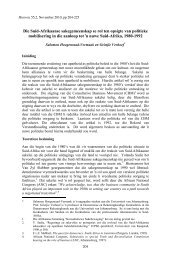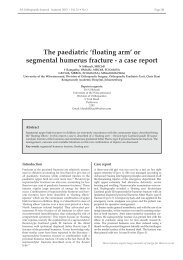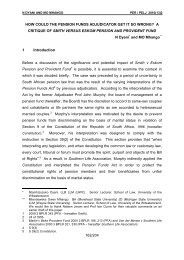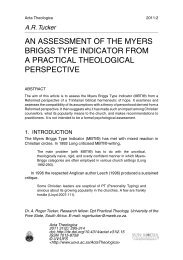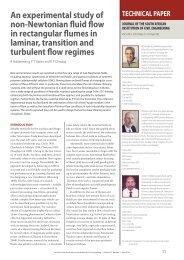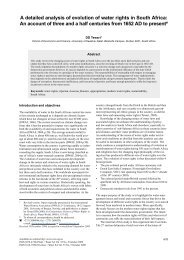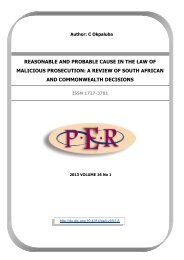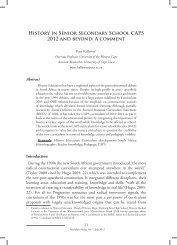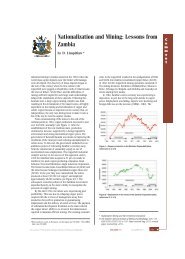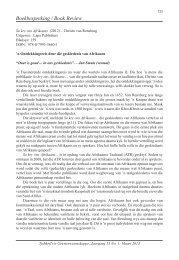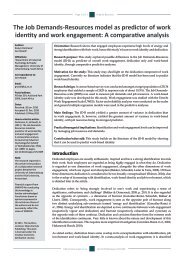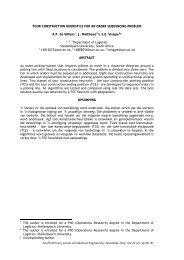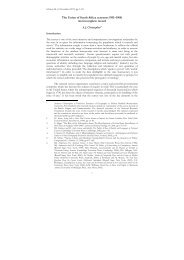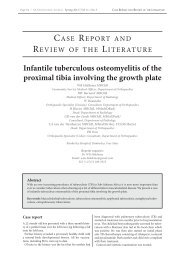S.Afr. Tydskr. Landbouvoorl./S. Afr. J. Agric. Ext., Van Niekerk ...
S.Afr. Tydskr. Landbouvoorl./S. Afr. J. Agric. Ext., Van Niekerk ...
S.Afr. Tydskr. Landbouvoorl./S. Afr. J. Agric. Ext., Van Niekerk ...
- TAGS
- niekerk
- www.scielo.org.za
Create successful ePaper yourself
Turn your PDF publications into a flip-book with our unique Google optimized e-Paper software.
S.<strong>Afr</strong>. <strong>Tydskr</strong>. <strong>Landbouvoorl</strong>./S. <strong>Afr</strong>. J. <strong>Agric</strong>. <strong>Ext</strong>., <strong>Van</strong> <strong>Niekerk</strong>, Stroebel, <strong>Van</strong><br />
Vol. 39 Nr 2, 2011: 57 – 68 Rooyen, Whitfield & Swanepoel<br />
ISSN 0301-603X (Copyright)<br />
TOWARDS REDESIGNING THE AGRICULTURAL EXTENSION SERVICE IN<br />
SOUTH AFRICA: VIEWS AND PROPOSALS OF EXTENSIONISTS IN THE EASTERN<br />
CAPE.<br />
J. A. <strong>Van</strong> <strong>Niekerk</strong>, 9 A. Stroebel, 9 C. J. <strong>Van</strong> Rooyen 10 , K. P. Whitfield 9 & F. C. J. Swanepoel 9<br />
11 .<br />
Corresponding author: J. A. van <strong>Niekerk</strong>, Centre for Sustainable <strong>Agric</strong>ulture, Rural Development &<br />
<strong>Ext</strong>ension, University of the Free State, P.O. Box 339, Bloemfontein, 9300; Email: vniekerkja@ufs.ac.za<br />
Keywords: Objective-Orientated Intervention Planning; <strong>Ext</strong>ensionists; Eastern Cape<br />
ABSTRACT<br />
The Eastern Cape’s Department of <strong>Agric</strong>ulture’s extension service is in vital need of<br />
revitalization. The extension recovery plan has started this process, but international<br />
developments in agricultural extension suggest that the present extension model is outdated. The<br />
purpose of this paper is to firstly, acquire a SWOT-analysis from the extensionists on what they<br />
perceive to be the services strengths, weaknesses, opportunities and threats.<br />
Secondly, to enquire of the extensionists what they perceive to be the problems that the service is<br />
facing as well as their perceived roles, the desired outcomes of the extension service and<br />
activities to attain these outcomes. This is achieved through using an Objective-Orientated<br />
Intervention Planning process, which is an adapted form of Logical Framework Analysis.<br />
The main results from this study were what the extensionists perceived to be the activities<br />
required to reach the desired outcomes of effective extension. This paper is highly relevant as it<br />
follows a bottom-up approach in acquiring what extensionists believe to be the way forward and<br />
this paper will contribute to a forthcoming paper that will propose a redesigned extension<br />
service.<br />
1. INTRODUCTION<br />
The South <strong>Afr</strong>ican agricultural extension service is challenged to improve food security, develop<br />
the rural areas through agricultural activity and to create sustainable jobs in farming. This is<br />
essentially promoted through the transfer of information and technologies to farmers in order to<br />
increase sustainable agriculture. According to Mudau, Geyser, Nesamvuni & Belemu (2009),<br />
recent policy formulation has introduced the <strong>Ext</strong>ension Recovery Plan (ERP), which aims to<br />
energise the extension service and bring it new hope. In the past, the extension workers felt<br />
9<br />
Centre for Sustainable <strong>Agric</strong>ulture, Rural Development & <strong>Ext</strong>ension, University of the Free State, P.O. Box 339,<br />
Bloemfontein, 9300.<br />
10<br />
Standard Bank Centre for Agribusiness Leadership & Mentoring Development, University of Stellenbosch<br />
11<br />
Director: Research Development, University of the Free State<br />
57
S.<strong>Afr</strong>. <strong>Tydskr</strong>. <strong>Landbouvoorl</strong>./S. <strong>Afr</strong>. J. <strong>Agric</strong>. <strong>Ext</strong>., <strong>Van</strong> <strong>Niekerk</strong>, Stroebel, <strong>Van</strong><br />
Vol. 39 Nr 2, 2011: 57 – 68 Rooyen, Whitfield & Swanepoel<br />
ISSN 0301-603X (Copyright)<br />
dejected as they were uncertain about their future and the future of extension. The ERP was<br />
informed by the need to overhaul the extension service and it is based on five pillars, namely:<br />
1. Ensure accountability and visibility of extension;<br />
2. Promote professionalism and improve the extension image;<br />
3. Re-skilling and orientation of extensionists;<br />
4. Provision of Information & Communication Technology (ICT) infrastructure and other<br />
resources; and<br />
5. Recruitment of personnel over the Medium-Term Expenditure Framework (MTEF).<br />
According to Swanson & Rajalahti (2010), there are three major agricultural development goals<br />
at the national level, which determine the activities of the extension system. The development<br />
goals are to (1) achieve national food security, (2) improve rural livelihoods and (3) improve<br />
natural resource management. The activities required by the extension service to reach these<br />
goals overlap. To achieve short-term food security, the extension service needs to transfer<br />
technologies that will increase staple food crop production. To improve rural livelihoods, the<br />
extension service must help farmers increase their farm income by increasing the production of<br />
high-value products, diversifying their farming systems and organizing farmers into producer<br />
groups to increase their market access. Lastly, to improve natural resource management, the<br />
extension service must train farmers in sustainable natural resource management practices. This<br />
should help achieve long-term national food security.<br />
In this context and according to <strong>Van</strong> den Ban & Hawkins (1996), the definition of agricultural<br />
extension is that “extension involves the conscious use of communication of information to help<br />
people form sound opinions and make good decisions”. An updated definition was proposed by<br />
Leeuwis (2004), which takes into account the various new developments in the field of<br />
agricultural extension. This definition states that extension is “a series of embedded<br />
communicative interventions that are meant, among others, to develop and/or induce innovations<br />
which supposedly help to resolve (usually multi-actor) problematic situations.”<br />
A holistic approach will be taken in this study involving recent policy statements (Bese, 2010)<br />
and discussions with the leadership of extension in the Eastern Cape’s Department of <strong>Agric</strong>ulture<br />
(ECDoA), and also by taking note of views and perceptions of other important stakeholders and<br />
role players. A first paper on the topic accounts for the views of relevant scientific role players<br />
and was published in the South <strong>Afr</strong>ican Journal of <strong>Agric</strong>ultural <strong>Ext</strong>ension in 2009 (van <strong>Niekerk</strong>,<br />
Stroebel, van Rooyen, Whitfield & Swanepoel, 2009). A second paper focused on the<br />
perspectives of smallholder farmers and is presently under review for the aforementioned<br />
journal. This paper contributes a third dimension and reports on the views and perceptions of a<br />
representative group of extensionists residing in the seven regions of the Eastern Cape. Two<br />
more papers will follow this paper, concerning perceptions of professional services, i.e. farm<br />
management services and agribusinesses serving smallholder farmers in the province. A final<br />
paper will provide an overall synthesis and proposals towards redesigning the agricultural<br />
extension system.<br />
58
S.<strong>Afr</strong>. <strong>Tydskr</strong>. <strong>Landbouvoorl</strong>./S. <strong>Afr</strong>. J. <strong>Agric</strong>. <strong>Ext</strong>., <strong>Van</strong> <strong>Niekerk</strong>, Stroebel, <strong>Van</strong><br />
Vol. 39 Nr 2, 2011: 57 – 68 Rooyen, Whitfield & Swanepoel<br />
ISSN 0301-603X (Copyright)<br />
2. RESEARCH METHODOLOGY<br />
In this study a representative selection of fourteen practicing extensionists, from the seven<br />
regions of the Eastern Cape, were selected by the province’s Department of <strong>Agric</strong>ulture who<br />
were required to describe the current extension system in the Eastern Cape and what they<br />
perceive as their role in agricultural extension.<br />
The first input was made by way of a SWOT analysis in the Eastern Cape’s Department of<br />
<strong>Agric</strong>ulture. The second aspect concerned the role the extensionists should/could play through an<br />
Objective-Orientated Intervention Planning (OOIP) procedure, which is an adapted form of a<br />
Logical Framework Analysis (LFA). The OOIP-enquiry is founded on constructivism whereby<br />
the process facilitator assists multiple participants in reconstructing a problem into a solution<br />
around a logical consensus (Denzin & Lincoln, 1994). The aim of the OOIP-enquiry is to<br />
analyse, plan, implement and evaluate possible intervention in order to improve efficiency and<br />
effectiveness (van Rooyen, Swart, D’Haese, Wessels & Carstens, 2002).<br />
The OOIP is based on intervention logic of goals and the required objectives, results and sets of<br />
activities, and is conducted in a formal planning process (van Rooyen, Anandajayasekeram,<br />
Rukuni, Marassas, D’Haese & D’Haese, 2006). According to van Rooyen, D’Haese &<br />
Anandajayasekeram (2002), this tool is essentially used to clarify cause-effect relationships as<br />
well as clarifying logical links “between inputs and objectives; activities and outputs; broader<br />
purposes and the ultimate goals” that the tool was meant to serve. This tool is therefore a<br />
systematic planning process that is based on logical deductions (van Rooyen, et al, 2006).<br />
This process revealed the perceptions of the extensionists regarding their core objective or<br />
mission as well as the outcomes they envisaged to be accomplished when the core objectives<br />
were met. The activities or programmes that needed to be performed for the core objectives and<br />
subsequent envisaged outcomes were also identified by the extensionists.<br />
59
S.<strong>Afr</strong>. <strong>Tydskr</strong>. <strong>Landbouvoorl</strong>./S. <strong>Afr</strong>. J. <strong>Agric</strong>. <strong>Ext</strong>., <strong>Van</strong> <strong>Niekerk</strong>, Stroebel, <strong>Van</strong><br />
Vol. 39 Nr 2, 2011: 57 – 68 Rooyen, Whitfield & Swanepoel<br />
ISSN 0301-603X (Copyright)<br />
3. RESULTS: SWOT ANALYSIS<br />
3.1 Strengths<br />
The extensionists identified the following as their strengths:<br />
a) Farmer development through group sessions and demonstration trials. Transferring<br />
information to farmers through regular interactions as above and instilling new ideas to<br />
farmers and thus improving their farming skills;<br />
b) Participative action through working with people on the ground and involving them in the<br />
development process;<br />
c) Service delivery through the regulation and management of government support<br />
programmes;<br />
d) Well structured service with suitably qualified officials (both extension and senior<br />
officials); and<br />
e) Providing support to policy formulation.<br />
3.2 Weaknesses<br />
The following weaknesses were identified by the extensionists:<br />
a) Ineffective management with poor implementation of policy formulation as well as a topdown<br />
approach;<br />
b) Being a “jack of all trades and master of none” as there is no specialization;<br />
c) Scarce resources, including finances, for farmer development; and<br />
d) Poor communication with farmers and within the service.<br />
3.3 Opportunities<br />
Several opportunities were identified, these are:<br />
a) Improvement of knowledge through training provided, thus assisting people to move<br />
from point A to point B in their development;<br />
b) Increase in production and hence, increases in food security;<br />
c) Easy access to other agriculturally-related industries; and<br />
d) Good communication skills with farmers.<br />
3.4 Threats<br />
Threats that were identified included:<br />
60
S.<strong>Afr</strong>. <strong>Tydskr</strong>. <strong>Landbouvoorl</strong>./S. <strong>Afr</strong>. J. <strong>Agric</strong>. <strong>Ext</strong>., <strong>Van</strong> <strong>Niekerk</strong>, Stroebel, <strong>Van</strong><br />
Vol. 39 Nr 2, 2011: 57 – 68 Rooyen, Whitfield & Swanepoel<br />
ISSN 0301-603X (Copyright)<br />
a) Lack of technology and information for workers, such as the prevailing weather<br />
conditions;<br />
b) The development of unproductive farmers who cannot be commercial farmers;<br />
c) Competition between other departments and Non-Government Organizations (NGO’s) in<br />
the same areas;<br />
d) Political will to effect change as well as interference of politicians into technical aspects;<br />
and<br />
e) Too many bosses, thus making it impossible to work according to your programme.<br />
3.5 Analysis<br />
From the above, one can conclude the following about the state of affairs in the Eastern Cape’s<br />
extension service. Firstly, the extension service has strengths in farmer development,<br />
participative action, implementing government support programmes and suitably qualified<br />
personnel who can support policy formulation. Secondly, the extension service also has inherent<br />
weaknesses, such as the lack of effective management, a top-down approach within the service,<br />
the lack of specialisation, scarce resources for developmental efforts as well as poor<br />
communication within the service and with farmers. Thirdly, the extension service offers several<br />
opportunities for improvement. These include assistance in development through the transfer of<br />
knowledge and training so that production should increase. The service also has access to agriindustries<br />
and therefore potentially good chances of effective communication. Lastly, the service<br />
identified threats that included lack of information and technologies for extensionists,<br />
development of unproductive farmers, competition between other public departments and<br />
NGO’s, political interference and too many bosses.<br />
According to the Christoplos (2010), the Food & <strong>Agric</strong>ultural Organization (FAO) has<br />
recognised the need to mobilise the extension service to achieve a range of rural development<br />
goals. These goals can be achieved when weaknesses are turned into strengths, opportunities are<br />
fully utilized and threats are neutralised. Such goals include:<br />
� The enhancement of people’s access to technologies and related information;<br />
� Ensuring that farmers and actors in value chains can cope with changing markets;<br />
� The enablement of farmers to understand climate change and to be in a position to<br />
mitigate and adapt to the new challenges;<br />
� The support of rural communities in effectively managing their natural resources; and<br />
� The assistance to farmers to use their available resources optimally.<br />
61
S.<strong>Afr</strong>. <strong>Tydskr</strong>. <strong>Landbouvoorl</strong>./S. <strong>Afr</strong>. J. <strong>Agric</strong>. <strong>Ext</strong>., <strong>Van</strong> <strong>Niekerk</strong>, Stroebel, <strong>Van</strong><br />
Vol. 39 Nr 2, 2011: 57 – 68 Rooyen, Whitfield & Swanepoel<br />
ISSN 0301-603X (Copyright)<br />
4. RESULTS: OBJECTIVE-ORIENTATED INTERVENTION PLANNING<br />
This approach allows participating role players to state clearly the problems (see Figure 1:<br />
Problem Tree) as experienced by them and thereafter propose “solutions” as envisaged<br />
outcomes, core objectives, programmes and sets of activities (Figure 2:Objective Tree).<br />
4.1 Problem Statement Defined by the <strong>Ext</strong>ensionists<br />
The extensionists involved in this research identified the following as their core problems<br />
resulting in them being unable to transfer effectively information and technologies through<br />
communication, which in turn immobilises farmers to become commercially viable.<br />
62
S.<strong>Afr</strong>. <strong>Tydskr</strong>. <strong>Landbouvoorl</strong>./S. <strong>Afr</strong>. J. <strong>Agric</strong>. <strong>Ext</strong>., <strong>Van</strong> <strong>Niekerk</strong>, Stroebel, <strong>Van</strong><br />
Vol. 39 Nr 2, 2011: 57 – 68 Rooyen, Whitfield & Swanepoel<br />
ISSN 0301-603X (Copyright)<br />
Farmers not advancing<br />
from emerging to<br />
commercial agriculture or<br />
farmers stuck in<br />
subsistence agriculture<br />
Lack of training for EW<br />
and therefore also farmers<br />
Figure 1: Problem Tree<br />
EW not<br />
life-long<br />
learners<br />
Poverty<br />
Lack of capacity<br />
development<br />
Soft skills<br />
are poor<br />
Farmers not making<br />
profit and low standard of<br />
living conditions<br />
Unable to transfer technologies and<br />
mobilise farmers<br />
Irregular<br />
farmer<br />
meetings<br />
Ineffective<br />
communication system<br />
Unable to<br />
develop the<br />
“right”<br />
message<br />
Unemployment<br />
Lack of innovations<br />
Poor linkages with other<br />
actors<br />
Farmers<br />
not being<br />
mobilised<br />
Lack of sustainable<br />
development<br />
Lack of integrated<br />
support systems<br />
Poor linkages with other<br />
actors and therefore<br />
unable to provide<br />
complete “info packs”<br />
Lack of<br />
resources,<br />
i.e. working<br />
tools<br />
63
S.<strong>Afr</strong>. <strong>Tydskr</strong>. <strong>Landbouvoorl</strong>./S. <strong>Afr</strong>. J. <strong>Agric</strong>. <strong>Ext</strong>., <strong>Van</strong> <strong>Niekerk</strong>, Stroebel, <strong>Van</strong><br />
Vol. 39 Nr 2, 2011: 57 – 68 Rooyen, Whitfield & Swanepoel<br />
ISSN 0301-603X (Copyright)<br />
4.2 Core Objectives of <strong>Agric</strong>ultural <strong>Ext</strong>ension<br />
Their core objectives or mission as identified by the extensionists revolved around three key<br />
concepts namely “to transfer, to communicate and to mobilise”. This was interpreted as “the<br />
imparting of agricultural knowledge to farmers, for them to be able to optimise their production<br />
in a sustainable way and to enable them to achieve food security initially and thereafter to<br />
develop towards commercial production. This statement was refined to the training and<br />
development of farmers’ skills in agriculture so that they can produce quality food and to<br />
alleviate poverty. The core objectives, envisaged outcomes and, programmes and activities are<br />
displayed in Figure 2: Objective Tree.<br />
4.3 The Envisaged outcomes of the <strong>Ext</strong>ensionists’ efforts<br />
The extensionists envisaged five outcomes that would be achieved once the core objectives were<br />
met. These outcomes are:<br />
a) To alleviate poverty in their society through food production. According to Rivera,<br />
Qamar & <strong>Van</strong> Crowder (2001), farmers need to be convinced that the extension service is<br />
communicating valuable information towards income generation and improving their<br />
living standards. The extension service must therefore supply appropriate technologies in<br />
this regard.<br />
b) To develop farmers so that they can make a profit out of farming so that they can<br />
improve their standard of living. According to Pesche & Francois (2007), the extension<br />
service can help by improving farming and farm yields so that farmers can become<br />
empowered and support their livelihoods.<br />
c) To develop emerging farmers to be commercial farmers and to shift farmers from<br />
subsistence to commercial farming. According to Swanson (2008), due to economic<br />
growth in developing countries, there are opportunities for smallholder farmers to<br />
increase incomes by diversifying into high-value farm products, but this would require<br />
these farmers to learn new production and management techniques (human capital<br />
development).<br />
d) Sustainable farmer development focussing on poverty alleviation and job creation by<br />
means of implementing the five pillars of sustainability. According to Smyth &<br />
Dumanski (1993, quoted by Dumanski, 1997), the five pillars of sustainability revolve<br />
around social equity, economic viability, maintenance of productivity levels, protection<br />
of the environment and reduction of production risks.<br />
64
S.<strong>Afr</strong>. <strong>Tydskr</strong>. <strong>Landbouvoorl</strong>./S. <strong>Afr</strong>. J. <strong>Agric</strong>. <strong>Ext</strong>., <strong>Van</strong> <strong>Niekerk</strong>, Stroebel, <strong>Van</strong><br />
Vol. 39 Nr 2, 2011: 57 – 68 Rooyen, Whitfield & Swanepoel<br />
ISSN 0301-603X (Copyright)<br />
Develop emerging farmers to<br />
commercial farmers and shift<br />
farmers from subsistence to<br />
commercial<br />
EW trained<br />
before they<br />
train farmers:<br />
through<br />
continuous or<br />
short courses<br />
Training<br />
Farmers<br />
trained in farm<br />
management<br />
On-farm<br />
demonstrations<br />
Figure 2: Objective Tree<br />
EW being<br />
life-long<br />
learners<br />
Alleviation of poverty through<br />
food production<br />
Capacity development<br />
Improving<br />
“soft” skills in<br />
order to build<br />
better<br />
relationships<br />
Regular<br />
farmer<br />
meetings<br />
To transfer, communicate and<br />
mobilise farmers<br />
Improved communication<br />
systems<br />
Develop farmers to make profit<br />
and improve their standard of<br />
living<br />
Developing<br />
right message;<br />
while<br />
respecting ITK<br />
&<br />
understanding<br />
farmer typology<br />
Innovation<br />
Strong links with<br />
other actors to<br />
have access to<br />
latest<br />
developments<br />
Sustainable farmer development to<br />
alleviate poverty & create jobs by<br />
implementing the 5 pillars of<br />
sustainability<br />
Farmer<br />
mobilisation<br />
Integrated support<br />
system<br />
Linking with other<br />
actors to provide<br />
complete “info<br />
packs”<br />
Provision of<br />
resources<br />
i.e. working<br />
tools<br />
65
S.<strong>Afr</strong>. <strong>Tydskr</strong>. <strong>Landbouvoorl</strong>./S. <strong>Afr</strong>. J. <strong>Agric</strong>. <strong>Ext</strong>., <strong>Van</strong> <strong>Niekerk</strong>, Stroebel, <strong>Van</strong><br />
Vol. 39 Nr 2, 2011: 57 – 68 Rooyen, Whitfield & Swanepoel<br />
ISSN 0301-603X (Copyright)<br />
4.4 Programmes and activities<br />
The extensionists identified five core activities that needed to be fulfilled in order to reach the<br />
objectives and desired outcomes. The five activities had sub-activities that needed to be<br />
accomplished before a specific activity’s goals could be achieved. These activities (and their<br />
sub-activities) are:<br />
a) Training:<br />
� <strong>Ext</strong>ensionists need to be trained before they train the farmers. This could be<br />
achieved through continuous or short-course training.<br />
� The farmers needed training in farm management, which included book<br />
keeping, decision making, marketing, financial skills, time management and<br />
risk management.<br />
� On-farm demonstrations should be used as a training tool.<br />
b) Integrated support systems:<br />
� Farmer mobilization, namely “farmers must be ready to adopt new ideas<br />
introduced to them” and extension workers should link up with farmer<br />
associations.<br />
� The extensionists must link up with agribusinesses and subject-matter<br />
specialists so that the extensionists can provide complete “information packs”.<br />
� The provision of resources, which consisted of access to working tools and the<br />
implementation of farmer contact sessions.<br />
c) Innovation:<br />
� This activity could be accomplished if the extensionists had strong linkages<br />
with agribusinesses, top commercial farmers and research stations. In this<br />
way, extensionists would be in a position to access the latest developments in<br />
agricultural innovations and technologies.<br />
d) Improved communication systems:<br />
� Regular farmer meetings.<br />
� Developing the “right” message, respecting local indigenous knowledge and<br />
understanding the relevant farming systems (typology analysis).<br />
e) Capacity development:<br />
� <strong>Ext</strong>ensionists themselves being “life-long learners”.<br />
� Improving extensionists soft skills, in other words, being able to build good<br />
social relationships.<br />
66
S.<strong>Afr</strong>. <strong>Tydskr</strong>. <strong>Landbouvoorl</strong>./S. <strong>Afr</strong>. J. <strong>Agric</strong>. <strong>Ext</strong>., <strong>Van</strong> <strong>Niekerk</strong>, Stroebel, <strong>Van</strong><br />
Vol. 39 Nr 2, 2011: 57 – 68 Rooyen, Whitfield & Swanepoel<br />
ISSN 0301-603X (Copyright)<br />
5. CONCLUDING REMARKS<br />
From this analysis extensionists determined that their core objective is “to transfer,<br />
communicate and mobilise farmers” although they could not achieve this objective at present.<br />
They suggested that five core activities were needed to improve the extension service. These<br />
activities were training, integrated support systems, innovation, improved communication<br />
systems and capacity development; with each of these activities having sub-activities.<br />
Once these activities have been holistically achieved, their envisaged outcomes were the<br />
alleviation of poverty, the profitability of farming, farmers develop from subsistence and<br />
emerging status to commercial farmers and agriculture becoming more sustainable.<br />
REFERENCES<br />
BESE, D., 2010. Policy speech 2010/11. Eastern Cape Department of <strong>Agric</strong>ulture and Rural<br />
Development, Bhisho, South <strong>Afr</strong>ica.<br />
CHRISTOPLOS, I., 2010. Mobilizing the potential of rural and agricultural extension. FAO,<br />
Rome.<br />
DENZIN, N. K. & LINCOLN, Y. S., 1994. Handbook of qualitative research. Sage<br />
Publications, Thousand Oaks, USA.<br />
DUMANSKI, J., 1997. Planning for sustainability in agricultural development projects.<br />
Journal for <strong>Agric</strong>ulture and Rural Development. pp 16.<br />
LEEUWIS, C., 2004. Communication for rural innovation: Rethinking agricultural extension<br />
(3 rd Ed.). Blackwell Publishing, Oxford.<br />
MUDAU, K. S., GEYSER, M., NESAMVUNI, A. E. & BELEMU, N. D. 2009. Towards<br />
sustainable strategies and tactics for extension recovery. Proceedings from the 42 nd<br />
Annual Conference of the South <strong>Afr</strong>ican Society for <strong>Agric</strong>ultural <strong>Ext</strong>ension.<br />
PESCHE, D. & FRANCOIS, J. L., 2007. Common framework on agricultural extension.<br />
Neuchatel Group, Lindau, Switzerland.<br />
RIVERA, W. M., QAMAR, M. K. & VAN CROWDER, L., 2001. <strong>Agric</strong>ultural and rural<br />
extension worldwide: Options for institutional reform in the developing countries. FAO,<br />
Rome.<br />
SWANSON, B. E., 2008. Global review of good agricultural extension and advisory service<br />
practices. FAO, Rome<br />
SWANSON, B. E. & RAJALAHTI, R., 2010. Strengthening agricultural and advisory<br />
systems: Procedures for assessing, transforming, and evaluating extension systems. World<br />
Bank, Washington.<br />
VAN DEN BAN, A. W. & HAWKINS, H. S., 1996. <strong>Agric</strong>ultural extension (2 nd Ed.).<br />
Blackwell Publishing, Oxford.<br />
VAN NIEKERK, J. A., STROEBEL, A., VAN ROOYEN, C. J., WHITFIELD, K. P. &<br />
SWANEPOEL, F. J. C., 2009. Towards designing a new agricultural extension service for<br />
the Eastern Cape Province: A perception analysis. S. <strong>Afr</strong>. J. <strong>Agric</strong>. <strong>Ext</strong>. 38: 65-76.<br />
VAN ROOYEN, C. J., ANANDAJAYASEKERAM, P., RUKUMI, M., MARASSAS, C.,<br />
D’HAESE, M. & D’HAESE, L., 2006. <strong>Agric</strong>ultural project planning & analysis. Network<br />
Activity Programme, Pretoria.<br />
VAN ROOYEN, C. J., D’HAESE, L. & ANANDAJAYASEKERAM, P., 2002. Logical<br />
framework analysis as a method of strategic planning. Ch. 21 In: Agribusiness: A source<br />
book for agribusiness training (Eds.: C.J. van Rooyen, O.T. Doyer, F. Bostyn & L.<br />
D’Haese). Network Activity Programme, Pretoria.<br />
67
S.<strong>Afr</strong>. <strong>Tydskr</strong>. <strong>Landbouvoorl</strong>./S. <strong>Afr</strong>. J. <strong>Agric</strong>. <strong>Ext</strong>., <strong>Van</strong> <strong>Niekerk</strong>, Stroebel, <strong>Van</strong><br />
Vol. 39 Nr 2, 2011: 57 – 68 Rooyen, Whitfield & Swanepoel<br />
ISSN 0301-603X (Copyright)<br />
VAN ROOYEN, C. J., SWART, D., D’HAESE, L., WESSELS, J. & CARSTENS, J., 2002.<br />
A strategic plan for the South <strong>Afr</strong>ican ostrich industry. Ch. 42 In: Agribusiness: A source<br />
book for agribusiness training (Eds.: C.J. van Rooyen, O.T. Doyer, F. Bostyn & L.<br />
D’Haese). Network Activity Programme, Pretoria.<br />
68



